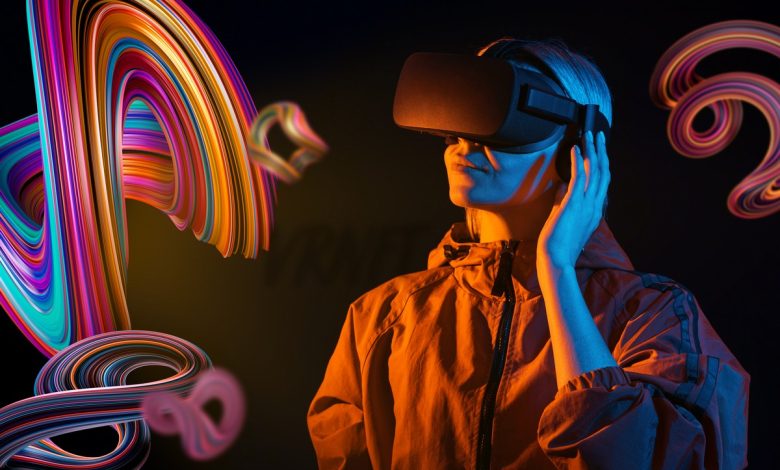NFTs and Virtual Reality

- Exploring the intersection of NFTs and Virtual Reality
- The rise of NFTs in the virtual world
- How NFTs are reshaping the virtual reality landscape
- Unlocking new possibilities with NFTs in virtual reality
- The future of digital ownership: NFTs and virtual reality
- Navigating the exciting world of NFTs and virtual reality
Exploring the intersection of NFTs and Virtual Reality
The intersection of NFTs and Virtual Reality is an exciting space where digital assets and immersive experiences come together. NFTs, or non-fungible tokens, are unique digital tokens that represent ownership of a specific item or piece of content. Virtual Reality, on the other hand, is a technology that allows users to immerse themselves in a computer-generated environment.
When NFTs are integrated into Virtual Reality experiences, it opens up a world of possibilities for creators and users alike. Imagine owning a virtual piece of art that you can display in your own VR gallery, or a rare virtual item that you can use in a VR game. The combination of NFTs and Virtual Reality allows for new ways to buy, sell, and interact with digital assets in a more immersive and engaging way.
One of the key benefits of combining NFTs and Virtual Reality is the ability to create unique and scarce digital assets that can be bought, sold, and traded in virtual worlds. This can lead to new opportunities for artists, game developers, and other creators to monetize their work in a decentralized and secure way. Additionally, the use of blockchain technology in NFTs ensures that ownership of these digital assets is transparent and verifiable.
As the technology continues to evolve, we can expect to see even more innovative use cases for NFTs in Virtual Reality. From virtual real estate to digital fashion, the possibilities are endless. By exploring the intersection of NFTs and Virtual Reality, we are shaping the future of digital ownership and immersive experiences.
The rise of NFTs in the virtual world
The rise of NFTs in the virtual world has been nothing short of revolutionary. Non-fungible tokens have opened up a whole new realm of possibilities for creators and collectors alike. With the ability to tokenize digital assets, artists can now sell their work directly to consumers without the need for intermediaries.
One of the most exciting developments in this space is the integration of NFTs into virtual reality environments. This allows users to not only own unique digital assets but also to interact with them in immersive virtual worlds. Imagine owning a piece of virtual real estate or a rare in-game item that can be bought, sold, and traded just like physical assets.
As more and more people embrace virtual reality as a form of entertainment and social interaction, the demand for NFTs in this space is only expected to grow. This presents a huge opportunity for artists, game developers, and other creators to monetize their work in new and innovative ways.
How NFTs are reshaping the virtual reality landscape
NFTs have been making waves in the virtual reality landscape, revolutionizing the way digital assets are bought, sold, and traded. These unique tokens are transforming the virtual reality market by providing a secure and transparent way to authenticate ownership of virtual assets. By leveraging blockchain technology, NFTs ensure that each digital item is one-of-a-kind and cannot be replicated or counterfeited.
One of the key ways NFTs are reshaping the virtual reality landscape is by enabling creators to monetize their virtual creations in new and innovative ways. Artists, game developers, and virtual world builders can now tokenize their digital assets as NFTs, allowing them to sell their work directly to collectors and fans. This direct-to-consumer model eliminates the need for intermediaries, giving creators more control over their work and a larger share of the profits.
Furthermore, NFTs are fostering a sense of ownership and community within virtual reality environments. By owning an NFT representing a virtual asset, users have a tangible stake in the digital world they inhabit. This sense of ownership can lead to increased engagement, loyalty, and investment in virtual reality platforms, creating a more vibrant and sustainable ecosystem for creators and users alike.
Unlocking new possibilities with NFTs in virtual reality
NFTs have opened up a whole new world of possibilities in the realm of virtual reality. By leveraging blockchain technology, NFTs are revolutionizing the way we interact with digital assets in virtual environments.
One of the key advantages of using NFTs in virtual reality is the ability to truly own and trade unique digital assets. This means that users can buy, sell, and exchange virtual items with a level of security and authenticity that was previously impossible.
Imagine being able to purchase a rare virtual piece of art or a limited edition virtual item, knowing that it is one-of-a-kind and cannot be replicated. With NFTs, this is now a reality, opening up new avenues for creators and collectors alike.
Furthermore, NFTs in virtual reality allow for new forms of monetization for content creators. By tokenizing their creations, artists, game developers, and other creators can sell their work directly to consumers, cutting out middlemen and ensuring fair compensation for their efforts.
Overall, the combination of NFTs and virtual reality is unlocking a world of new possibilities for digital ownership, creativity, and commerce. As the technology continues to evolve, we can expect to see even more innovative use cases emerge, shaping the future of virtual experiences.
The future of digital ownership: NFTs and virtual reality
The future of digital ownership is being reshaped by the emergence of Non-Fungible Tokens (NFTs) and virtual reality (VR) technology. NFTs are unique digital assets that are stored on a blockchain, making them secure and tamper-proof. These tokens can represent ownership of digital art, collectibles, virtual real estate, and more.
Virtual reality, on the other hand, allows users to immerse themselves in digital environments and interact with them in a more realistic way. By combining NFTs with VR, users can truly own and showcase their digital assets in virtual worlds. This opens up a whole new realm of possibilities for creators, collectors, and investors alike.
One of the key benefits of NFTs in virtual reality is the ability to prove ownership and authenticity of digital assets. This is crucial in a world where digital piracy and copyright infringement are rampant. With NFTs, creators can ensure that their work is protected and that they are fairly compensated for their efforts.
Furthermore, the integration of NFTs and VR can revolutionize the way we experience and interact with digital content. Imagine being able to walk through a virtual art gallery, admiring and purchasing digital artworks with the click of a button. Or owning a piece of virtual real estate in a bustling metaverse where you can socialize with others and attend virtual events.
In conclusion, the combination of NFTs and virtual reality has the potential to transform the concept of digital ownership as we know it. As these technologies continue to evolve and become more mainstream, we can expect to see a shift towards a more decentralized and immersive digital economy. It’s an exciting time to be at the forefront of this digital revolution.
Navigating the exciting world of NFTs and virtual reality
Exploring the intersection of NFTs and virtual reality opens up a world of endless possibilities for creators and consumers alike. NFTs, or non-fungible tokens, have revolutionized the way digital assets are bought, sold, and traded. Virtual reality, on the other hand, immerses users in a simulated environment where they can interact with these unique digital assets in a whole new way.
By combining NFTs with virtual reality, creators can showcase their digital art, music, and other creations in a more immersive and interactive manner. Users can explore virtual galleries, attend virtual concerts, and even participate in virtual auctions to acquire these one-of-a-kind digital assets.
As the technology behind NFTs and virtual reality continues to evolve, the possibilities for collaboration and innovation are endless. From virtual reality museums showcasing NFT art collections to virtual reality concerts featuring NFT music, the future of digital creativity knows no bounds.



